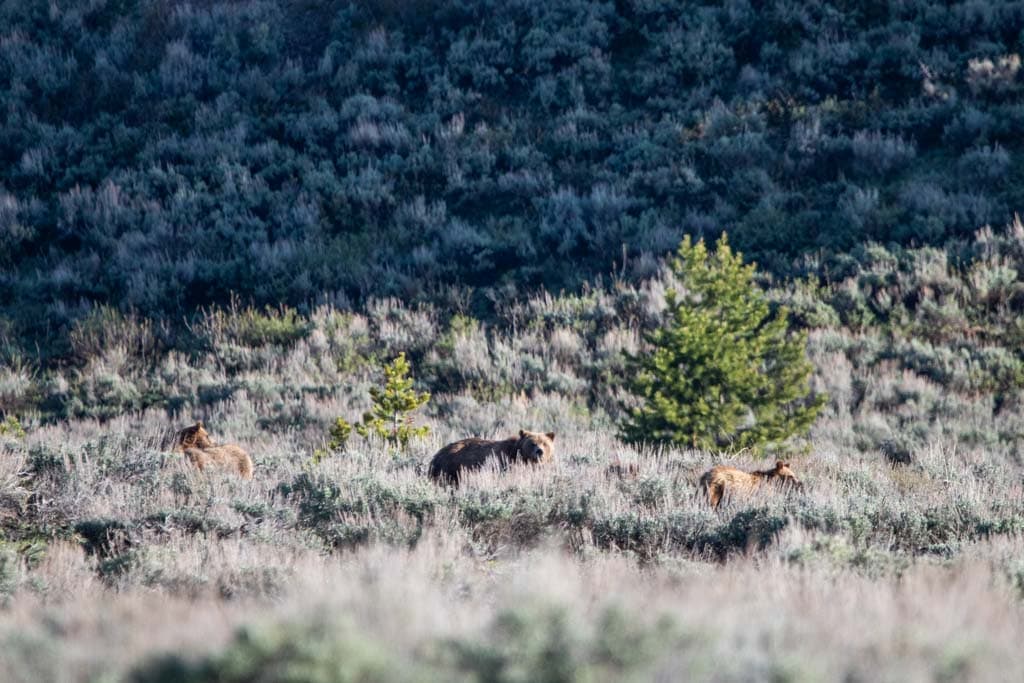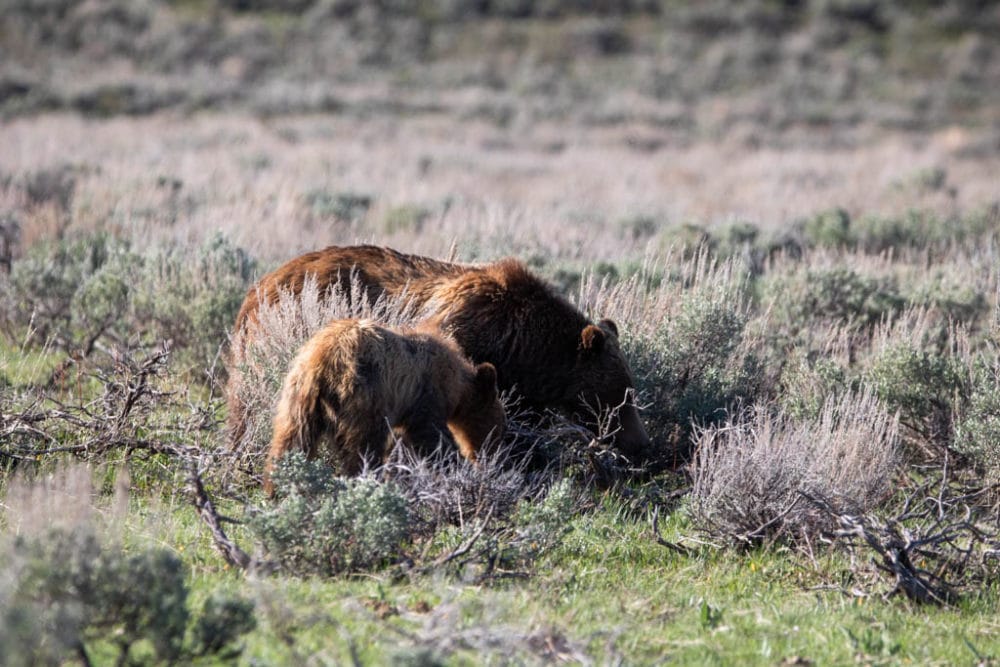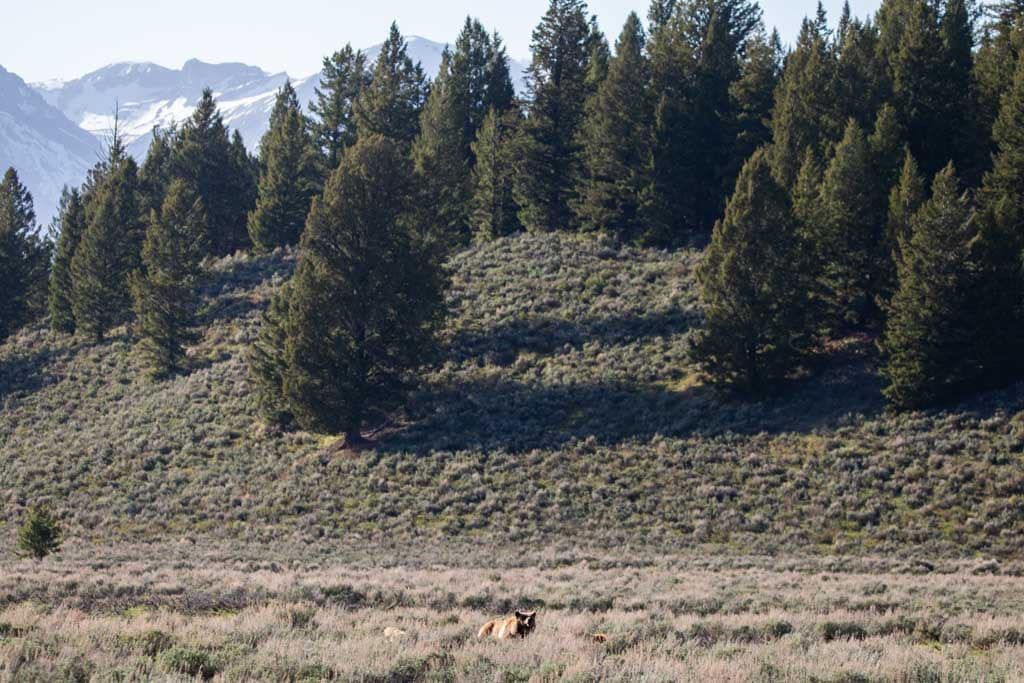Grizzly Bear 399’s Four Cubs Are Going Their Own Ways
This news story about the four cubs of famous grizzly bear 399 is based on a May 13, 2022, National Park Service press release. You can read the original release here.
For a couple of years, grizzly bear 399 and her four cubs were a popular sight in and around Grand Teton National Park, Wyoming. Seemingly at ease around people, this legendary grizzly sow was often spotted wandering through the sagebrush near the Teton Park Road and even in urban neighborhoods in Jackson.
This spring, the National Park Service announced, after two years of dedicated care and safekeeping, her four cubs have reached independence.
While it’s hard enough for a wild grizzly mom to keep just a couple of cubs alive through adolescence, protecting four of them against traffic, male grizzlies and other hazards is an almost heroic feat.
Now, the four cubs of grizzly bear 399 will go their own ways, which means nothing less than a life-or-death crossroads in their life. How and if they’ll manage to survive on their own is yet to be seen.
As the National Park Service emphasizes, now that these, and other, young grizzly bears need to fend for themselves, “the potential for conflict is high.”

Grizzly Bear 399’s Four Cubs Are Now Independent, Marking a Critical Crossroads in Their Lives
Grizzly bear 399 has successfully weaned her four offspring, which is normal for female grizzly bears with two-year-old cubs.
These young bears will eventually disperse to establish individual home ranges. Residents of Teton County should expect that these bears, and other recently weaned individual bears, could travel through their neighborhoods in pursuit of available habitat.
Young bears have a higher potential to become emboldened in seeking out foods in and around human development, especially if they have learned to acquire food there in the past.
When this food-conditioned behavior occurs, management options for bear and human safety become limited.
As interagency and community partners, BearWise Jackson Hole, Teton County, and the U.S. Fish and Wildlife Service will continue our collective efforts to proactively prevent conflicts between bears and people in Teton County.
During the last two years, grizzly bear 399 and her four cubs spent a significant amount of time near residential areas and received numerous food rewards.
These events serve as a critical reminder that all of Teton County is in occupied grizzly bear habitat.
Living and recreating in bear country requires awareness and actions on our part to keep both bears and humans safe.
As the grizzly bear population expands within the Greater Yellowstone Ecosystem, bears continue to disperse across their historical range but also into more populated areas.
Unfortunately, more often than not, “a fed bear is a dead bear.”

How to Keep Bears Wild and Humans Safe
Properly storing all attractants to ensure a bear does not obtain a food reward is crucial to keeping bears wild and humans safe.
BearWise Jackson Hole, Teton County, and the U.S. Fish and Wildlife Service would like to thank Teton County residents for their efforts to secure bear attractants this spring.
Grizzly bear 399 and her four offspring foraged naturally on private property for nearly two weeks with no conflicts recorded. This goes to show that our efforts and dedication as a community paid off. Let’s keep up the great work.
Whether you have lived in Teton County for decades or are visiting the area for a day, please do your part to help protect both black and grizzly bears.
If you are a resident
- Store all garbage within bear-resistant containers or in a secure building.
- Secure livestock feed, pet food, compost, and beehives.
- Hang birdfeeders in a way that makes them inaccessible to bears.
- Help your neighbors create a bear-wise community to protect wildlife.
If you are visiting a National Park or National Forest
- Keep a clean camp. Store all attractants, including coolers, cooking gear, and pet food, inside a bear box or a hard-sided vehicle with the windows rolled up.
- Properly store garbage until you can deposit into a bear-resistant dumpster.
- Never abandon your picnic table or backpack. Always keep your food within arm’s reach, day or night, unless properly stored.
- If you see a bear, please give it space and always stay at least 100 yards away. If you choose to watch or photograph the bear, use a spotting scope or telephoto lens. Park in designated areas and never block travel lanes. Follow the directions of staff at bear jams.
- Please respect all wildlife closure areas.
If you are exploring the backcountry
- Be alert and aware of your surroundings.
- Make noise, especially in areas with limited visibility or when sound is muffled.
- Carry bear spray, know how to use it, and keep it readily accessible.
- Hike in groups of three or more people.
- Do not run. Back away slowly if you encounter a bear.
You can read much more about grizzly bear safety in this blog post.

Please immediately report bear sightings and any conflict activities in the local community to the bear management professionals with the Wyoming Game and Fish Department, so the agency can respond properly to reduce conflict potential between bears and people.
BearWise Jackson Hole was established in 2006 as a local chapter of the Wyoming Bear Wise Community Program. It is a partnership between Wyoming Game and Fish Department, Grand Teton National Park, Bridger-Teton National Forest, and Jackson Hole Wildlife Foundation.
Their objective is to minimize the accessibility of unnatural attractants to bears and educate residents and visitors about bears and conflict prevention.
More Information
Visit the following links to learn more:
- Bear Wise Wyoming: https://wgfd.wyo.gov/bear-wise-wyoming
- Jackson Hole Wildlife Foundation: https://jhwildlife.org/our-work/bear-wise/
- Grand Teton National Park: https://go.nps.gov/tetonbears







Questions about 399 weaning cubs:
Would 399 have to chase them away, or would the cubs naturally wonder off on their own in a natural maturation process?
Would she have weaned all of them away at nearly the same time, or would she have done this more gradually?
No details about the specific situation concerning 399 have been released, so I can’t say for sure. However, there have been reports that 399 was seen with a large adult male around the time she and her cubs split up, which means she has become estrous again (ready to mate).
The presence of the adult male, which 399 would have either chased away or fled from before but tolerated now, very likely scared off the cubs in this case. This would have had the same affect on all four cubs at the same time. An entirely natural and normal process, this is how many bear families split up. Again, this is not officially confirmed, but it’s the most probable scenario.
Just leave the bears alone and chances are they’ll do just fine. But then there’s the jackass factor. Yes, those folks who always find a way to make life difficult for these magnificent creatures. And I don’t mean hunters!